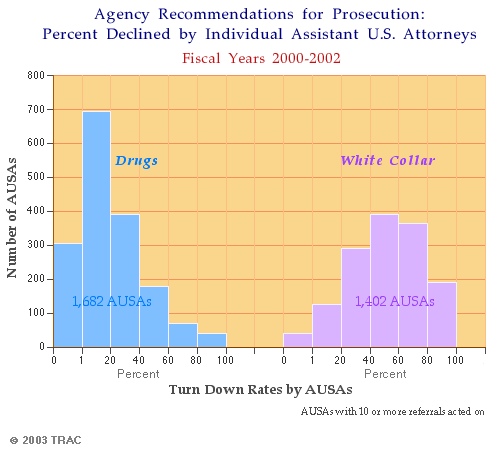
Federal Prosecutors: Wide Variation Found in Handling of Criminal Referrals for Prosecution A TRAC Special Report
January 24, 2003By both law and custom federal prosecutors have been granted extensive discretionary powers. Chief among them is the authority to decide whether those individuals whom the investigative agencies have determined should face criminal prosecution will actually be brought to trial.
The number of matters that are investigated and then declined is extensive. During the last three years, for example, the agencies recommended that federal criminal charges be brought against slightly more than 140,000 individuals each year. During the same period, around 45,000 of these matters were declined by federal prosecutors each year.
In determining whether the investigator's recommendation to prosecute will be accepted or declined, prosecutors rely on the particular facts in the case, their experience, statutory law (what the law says), case law (actual court decisions), and the varying expectations of the communities where they work. While the choice to prosecute or not has a major impact on the system of justice at the federal level, until TRAC introduced its new Prosecutors Tool in December 2002 there was no way to systematically examine how the approximately 5,000 currently practicing assistant U.S. attorneys (AUSAs) have actually exercised their most important power.
As suggested above, Justice Department records show that about one in every three referrals are declined by federal prosecutors. Reasons cited by the AUSAs for not going forward are numerous and include such factors as a lack of resources, weak evidence, and the submission of the matter to local authorities. Further analysis of the data, however, show the declination rates of individual AUSAs widely vary. At one extreme, for example, nearly 40 percent of the AUSAs who handled 25 or more cases prosecuted every single referral they received during the last three years. At the other end of the scale, were a smaller group of AUSAs --ten percent of them -- who declined half or more of their referrals.
There of course are legitimate reasons why the declination rates among AUSAs can vary. For each case, many factual and legal factors must be considered. The data indicate that a key factor influencing these rates is the kinds of cases handled by an individual prosecutors. At the national level, for example, federal prosecutors in recent years have turned down slightly more than one out of five of all drug referrals . But when it came to white collar crime matters, more than half of all referrals were declined.
Often AUSAs specialize in the types of cases they handle. For example, during the last three years only a small fraction of federal prosecutors -- about 1,700 out of the 5,000-plus AUSAs – were responsible for handling 10 or more potential defendants in drug matters. Put another way, this means that for the whole nation these 1,700 AUSAs handled 96 percent of all drug referrals. Similarly, about 1,400 AUSAs handled the bulk of white collar referrals during the same period. But even among these two select groups of AUSAs, widely different declination rates were recorded. While there was a tendency for AUSAs specializing in drug cases to prosecute more and turn down fewer referrals than their colleagues handling white collar referrals, in each group some AUSAs declined the majority of their referrals while others prosecuted every single one (see graph).

More information is available with TRAC's new Prosecutors Tool, available by subscription to the TRACFED service. With this tool the public, Congress, reporters, businesses, scholars and lawyers for the first time ever can quickly determine how individual AUSAs have exercised their powers in handling both criminal and civil matters. Activities from fiscal year 2002 to fiscal year 1986 are covered. Matter-by-matter listings as well as statistics on a wide variety of indicators are available. In regard to criminal matters, TRAC's data provide counts of referrals, matters declined, matters prosecuted and matters disposed of along with the reason for each disposition. Also available is information about the number of days between when the referral was recorded as being received and when a prosecution was filed and the number of days between a filing and the ultimate disposition. Furthermore, various averages, rates and percentages are available such as the percent of referrals declined, the percent of referrals leading to a prosecution and conviction rates. For those convicted, average and median sentences as well as the distribution by the length of sentence are available. For criminal matters the data can be examined by broad program category while civil matters can be viewed according to the cause of action.
